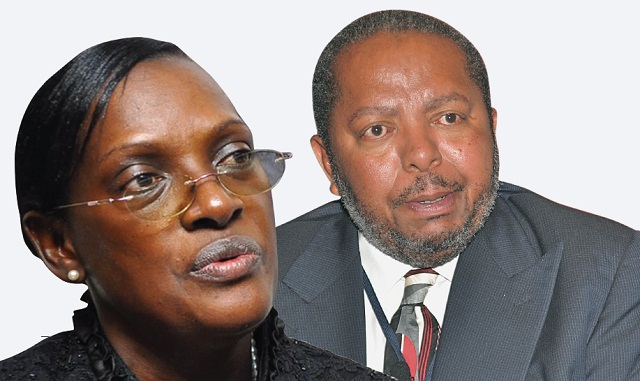
THE LAST WORD | Andrew M. Mwenda | Last week, Bank of Uganda (BOU) issued a press statement in which it promised to appeal a ruling by the Court of Appeal in a case against businessman Sudhir Ruparelia over Crane Bank. Yet the statement did not deal with the reason why the court rejected all the grounds of appeal by BOU. Instead, BOU sought to win public support, and perhaps even morally bribe Supreme Court judges, on fictitious claims that somehow Sudhir stole money from Crane Bank. Yet this is not a matter that was before the court.
The history of BOU sale of Crane Bank will go down in history as the biggest fraud in our financial history. BOU officials colluding with lawyers in private law firms indulged in acts of financial chicanery unseen in our country before. Their actions demonstrate high levels of corruption; but that was only the minor part. The fundamental problem was a toxic combination of excessive incompetence and gross abuse of power i.e. impunity.
In October 2016, Bank of Uganda took statutory management of Crane Bank on grounds that it was undercapitalized and illiquid (out of cash). In January 2017, they sold it to DFCU Bank. There was no forensic audit of Crank Bank. Instead BOU relied on a casual audit by PWC where Crane Bank officials were not interviewed on the anomalies identified, so the findings were speculative. Such audit cannot stand before any rigorous scrutiny leave alone a court of law.
In blatant violation of the provisions of the Financial Institutions Act of 2003, there was no valuation of the assets of Crane Bank that BOU sold to DFCU. Instead BOU asked DFCU to name a price at which it wanted to buy the assets and liabilities of Crane Bank. DFCU said it was willing to pay Shs 200 billion and BOU accepted this figure without negotiation. Yet BOU owed Ugandan taxpayers and the shareholders of Crane Bank a fiduciary responsibility to get a good value for the assets it was selling.
In its statement, BOU claimed to have sunk Shs 490 billion as liquidity support into Crane Bank during statutory management. Immediately before BOU takeover of Crane Bank, one of its major shareholders, Ruparelia, put into the bank $8m (Shs 30 billion). Another shareholder, Chhotalal Kantaria, gave BOU $7.5m (Shs 28 billion). After the sale of Crane, Sudhir paid yet another $8m (Shs 30 billion) to BOU. Therefore, BOU got a total of Shs 88 billion from shareholders and another Shs 490 billion from the taxpayer, making a total of Shs 578 billion and “sunk” it into Crane Bank.
The Auditor General has stated that BOU failed to account for the Shs 490 billion. Neither has it account for the Shs 88 billion. In fact, the legal secretary for BOU, one Margaret Kalule, said under oath both in court and before a parliamentary committee that the central bank did not lose any money in Crane Bank. Since BOU claims that the substantive matters of Crane Bank be discussed (as opposed to technicalities), will it allow the Supreme Court to address itself to these anomalies and question how it sunk Shs 578 billion into Crane Bank and sold it for Shs 200 billion?
DFCU did not even spend one shilling to buy Crane Bank assets and liabilities. Instead, BOU asked DFCU to take them over on credit spread over 36 months, effectively giving DFCU an interest free loan. DFCU would secure this credit by buying BOU treasury bills worth Shs 200 billion at 15% compound interest i.e. effectively paying DFCU to buy Crane Bank on credit. No wonder the Auditor Genera has asked BOU to provide for Shs 39 billion as interest foregone in giving DFCU an interest free credit line.
Crane Bank had a bad book worth Shs 570 billion. BOU gave this bad book zero value and passed on the DFCU for free. This was contrary to established practice where BOU previously retained the bad book of a closed bank, only assigning the bank assuming the assets and liabilities the role of debt collector on a commission basis.
In a case of conflict of interest, which suggests premeditated fraud, the law firms (MAAKS and Bowmans) that negotiated this deal as transaction advisors for BOU, and which allowed the bad book to be transferred to DFCU for free, were within a week hired by DFCU to collect this debt. Within the first five months they collected Shs 56 billion on the bad book they had had given zero value.
Then within the first five months of DFCU taking over Crane, its half-year profits jumped from Shs 23 billion for January to June 2016 to Shs 125 billion for the same period in 2017. This exposed the claims about Crane Bank’s bad health. So BOU Executive Director for bank supervision, Justine Bagyenda, wrote to DFCU instructing them to not put this money on their books. Then BOU sold 45 branches of Crane Bank to DFCU at Shs 10 billion. A week after buying them, DFCU valued them at Shs 40 billion.
Many people think this is a classic case of gross corruption. Clearly there was massive corruption in this transaction. But corruption alone cannot explain the depth of this mess. This was a classic case of impunity. Officials at BOU and the lawyers in private practice did all this because they judged, and now I see quite correctly, that they would go away with it – and they actually have.
Let me break down this deal in simple terms. President Yoweri Museveni is assigned to sell a fully furnished house belonging to Dr. Kizza Besigye. The house has rent arrears of Shs 500m owed to Besigye by Mugisha Muntu. It also has Amama Mbabazi living in it as a tenant paying rent of Shs 25m per month. Museveni uses Shs 500m taxpayer money to renovate the house. He then forces Besigye to give him Shs 90m and he adds it to the cost of renovation.
Then without valuing the house Museveni asks the prospective buyer, Bobi Wine, what he would like to pay. Bobi Wine offers Shs 200m and Museveni accepts without negotiation. Museveni then tells Bobi Wine to pay this money over a period of 36 months (three years). This allows Bobi Wine to collect rent from Mbabazi (Shs 300m per year, Shs 900 in three years) to pay for the house. Thus, on the sale price alone, Bobi Wine makes a cool Shs 700m.
To ensure security for the Shs 200m purchase price (which Museveni has actually given him on credit), Museveni asks Bobi Wine to deposit Shs 200m with him as collateral. Museveni promises to pay the singer a compound interest of 15% per year i.e. Shs 100m over the three years. Immediately Bobi Wine takes over the house, he sells some of the jewelry in the house and, in the first five months, gets Shs 100m from this. He also goes after Muntu, who in the first five months pays Shs 56m on his rent arrears.
So Bobi Wine bought a house at Shs 200m. But in the first five months alone he has benefited from Shs 590m worth of renovations, earns Shs 15m in interest from Museveni, earns another Shs 125m from rent, Shs 100m from selling jewelry i.e. gets value of Shs 830m, four times the cost he spend on buying the house. What would Ugandans and the Supreme Court say of such a transaction? If BOU believes the Supreme Court should hear the substantive issues of this case, these facts then must be the issues to adjudicate.
*******
amwenda@independent.co.ug
 The Independent Uganda: You get the Truth we Pay the Price
The Independent Uganda: You get the Truth we Pay the Price




Well put. But won’t it be logical to also consider the “good will” and the intrinsic value for the crane bank?
Mwenda do you want to tell me that your darling president is aloof of all this, or he fears so much to antagonize these powerful people at play!
Lastly I understand you have the presidents ear please forward him this info before they steal another bank!
Thank you!
1.Is there prove that BOU issued liquidity support of 490 billion shillings to Crane Bank?
2.In Banking; it was quite normal for BOU to identify a Bank to temporarily or permanently take over the management of a Bank that is crawling otherwise; if BOU had just closed down Crane Bank where would the clients have got their money from?( This was a good stop gap measure)
3.Something is just not right with Sudhir; In this era its not safe for a owner of a Bank to be a Businessman they tend to have alot of appetite for money they see on clients’ accounts.
4.Why shouldnt PWC ‘s audit report be believed now?Ooh how convenient.
5.Meera investments and Sudhir are one;What was the role of Meera investment in Crane Bank?Just go to Kabira club or Dolphin suites you will find all the cutlery are engraved with Speke Resort logs what else is not shared?
6.To Lawyers;at times its okay to tell court that your client is heavy ladened;In the Crane Bank Case;Sudhir’s lawyers are dwelling on the weakness of BOU’s absentminded staff yet BOU has more strength when it comes to Crane Bank flaunting banking statutory rules.( Its as if BOU lawyers are double dealers in the this case)
7. It has been proven in Uganda that Banks that owned by churches,cooperative society are more reliable because their goal is to serve the Public but not to make profits.
8.Rajab is so happy with Government during this COVID 19 period; they fed all his family including his wives in Congo.
I am sure the guys at BOU believe they have a strong based on the financial institutions act if court can allow them to present the substantiave issues. Banks don’t operate like everyday businesses. Just take a loan and you default you will see what they will do. If you owe the bank 500m, and your security for the loan is a property valued at say 2bn, they won’t hesitate to sell your property at 700m. All they are looking at is recovering their 500m.
Wherever and whenever this issue crops up,this old story never rises eyebrows.. What bothers me is what the chroniclers opt to leave out or is carefully hidden from view and will surface long after the criminals are gone!
Crane bank is now history but;it would be nice for clarity purposes for BOU to provide the public with the banking rules crane bank flaunted;otherwise to an ordinary peeson;it appears that crane is protesting its unfair sale and no one is telling the public why the bank collapsed.
Hello Andrew
I couldn’t read any further when I came across these two statements below
1. BOU relied on a casual audit from PWC
2. In January 2017, the bank was sold without valuation of its assets
What is a casual audit? Did you get a copy of the audit report? Please get facts right. It was not a casual audit as you stated.
2. Do you know that banks undergo annual aidits and as a result have rinning balance sheets showing assets and liabilities?